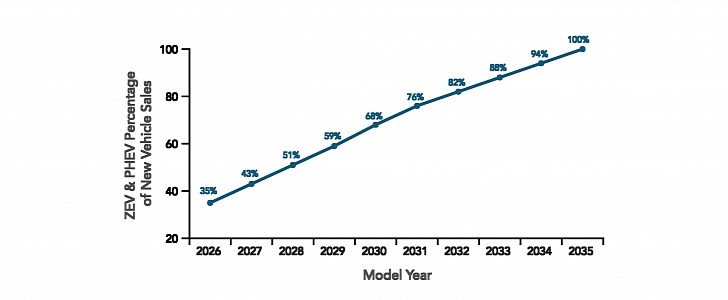California is the most important car market in the U.S. It is also one of the most affected ones by pollution: its smog problem earned the state the right to impose its own emission rules with California Air Resources Board (CARB). Governor Gavin Newsom and this entity have now decided to ban new internal combustion-engined car sales by 2035. The implications will be massive.
In a matter of 13 years, automakers will have to offer the same lineups they currently have composed exclusively of zero-emission vehicles (ZEVs). In other words, they will either have batteries or fuel cells.
Ironically, plug-in hybrid electric vehicles will also make the cut if they meet some criteria. CARB wants them to offer “at least 50 miles under real-world driving conditions.” Automakers willing to sell them must avoid meeting “more than 20% of their overall ZEV requirement with PHEVs.” That probably relates to sales, not to the lineup. Controlling that percentage will be a significant challenge for those insisting on combustion engines – even if solely as range extenders.
Another catch is that selling and buying used cars powered by engines will still be legal. California residents may also purchase their ICE vehicles in neighboring states and take them back home. For the ICE car ban to be effective, other states will have to follow California’s lead, which at least 16 of them already do.
Predictably, the change will be gradual. In 2026, 35% of any carmaker sales will have to be for ZEVs and PHEVs. That increases to 43% in 2027, 51% in 2028, 59% in 2029, 68% in 2030, 76% in 2031, 82% in 2032, 88% in 2033, 94% in 2034, and 100% in 2035. Medium and heavy-duty vehicles will have ten more years to adjust to the new rules. In other words, the requirement for them to be ZEVs or PHEVs will only apply in 2045.
After watching European countries establish deadlines for the end of combustion engines, the U.S. will start dealing with that, thanks to CARB. Although local automotive companies already promise electric cars for the next few years, the new Advanced Clean Cars II regulation and the Executive Order N-79-20 make the subject a lot more pressing.
Ironically, plug-in hybrid electric vehicles will also make the cut if they meet some criteria. CARB wants them to offer “at least 50 miles under real-world driving conditions.” Automakers willing to sell them must avoid meeting “more than 20% of their overall ZEV requirement with PHEVs.” That probably relates to sales, not to the lineup. Controlling that percentage will be a significant challenge for those insisting on combustion engines – even if solely as range extenders.
Another catch is that selling and buying used cars powered by engines will still be legal. California residents may also purchase their ICE vehicles in neighboring states and take them back home. For the ICE car ban to be effective, other states will have to follow California’s lead, which at least 16 of them already do.
Predictably, the change will be gradual. In 2026, 35% of any carmaker sales will have to be for ZEVs and PHEVs. That increases to 43% in 2027, 51% in 2028, 59% in 2029, 68% in 2030, 76% in 2031, 82% in 2032, 88% in 2033, 94% in 2034, and 100% in 2035. Medium and heavy-duty vehicles will have ten more years to adjust to the new rules. In other words, the requirement for them to be ZEVs or PHEVs will only apply in 2045.
After watching European countries establish deadlines for the end of combustion engines, the U.S. will start dealing with that, thanks to CARB. Although local automotive companies already promise electric cars for the next few years, the new Advanced Clean Cars II regulation and the Executive Order N-79-20 make the subject a lot more pressing.







